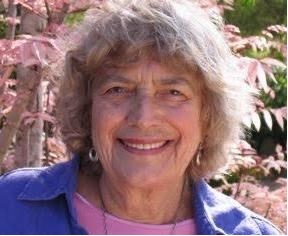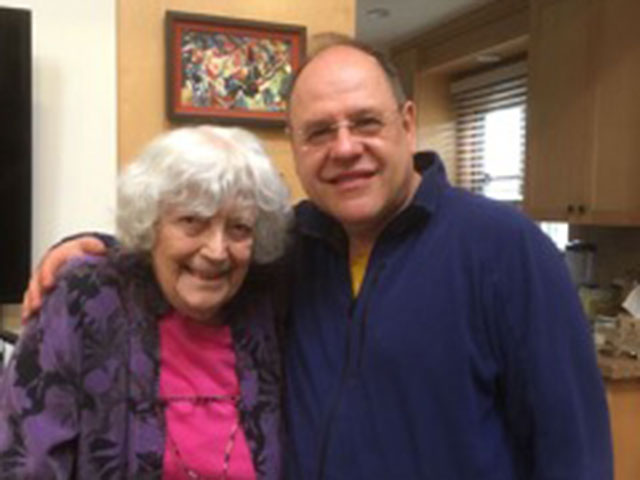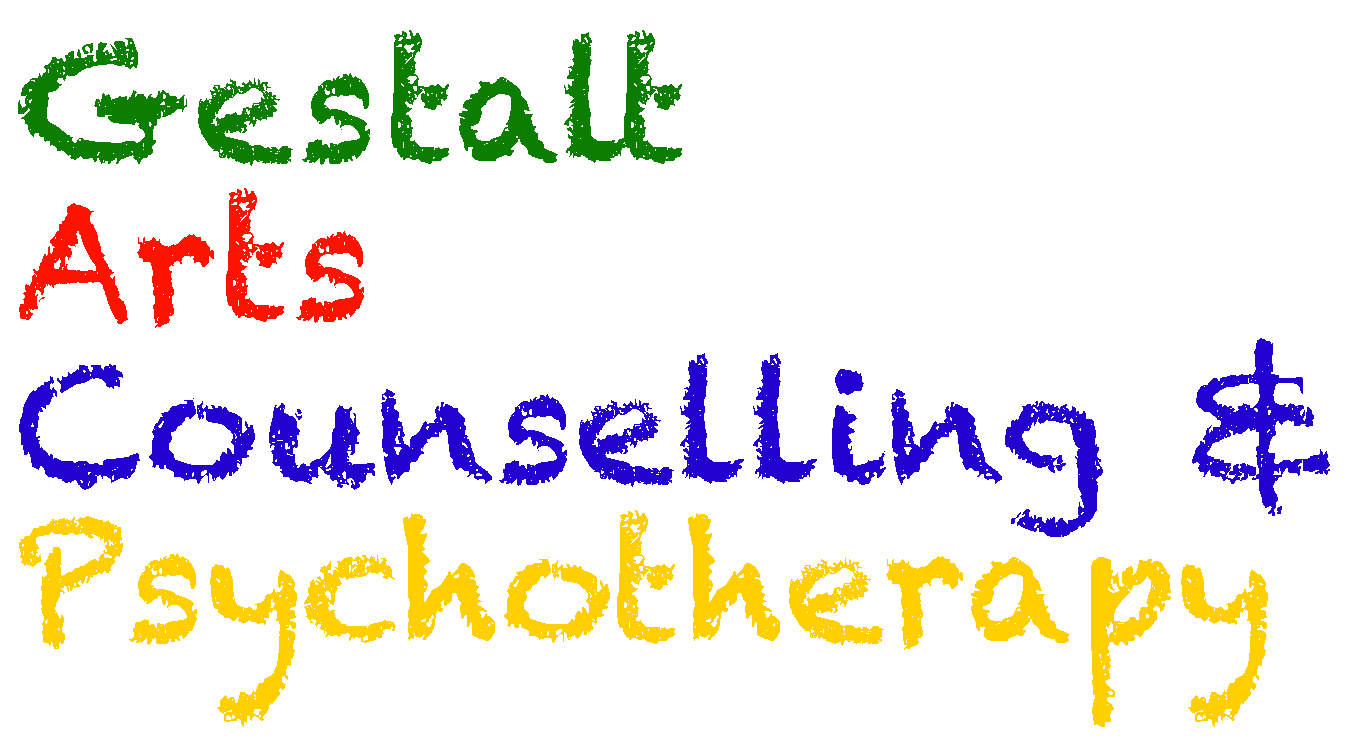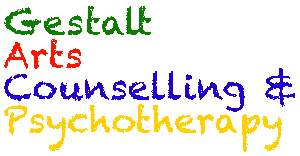
Violet Oaklander: 1927 to 2021
Violet Oaklander died aged 94 in Los Angeles on 21 September 2021.
She was born in Massachusetts in 1927, the youngest of three children, to parents Joseph and Mollie Solomon, Jewish immigrants from Russia.[Footnote 1] Though Violet grew up in a loving family her early life was marked by traumatic events. A home accident at age 5 resulted in her receiving multiple severe burns which necessitated her spending several months in hospital. She was kept in isolation, allowed few visitors and was not permitted any diversional activities with which to relieve her loneliness and boredom. The changing of her dressings proved excruciatingly painful; when she cried out the medical staff rebuked her, insisting she “be a good girl” and stay silent. Violet later attributed her mission to help children find support and comfort when facing adversity to the traumatic experience she endured in hospital.
As a person Violet exuded authenticity. She was lively, shrewd, warm and engaging with incredible presence. She could also be grumpy and ordinary. A lover of nature and a fan of art house movies she seemed, to borrow an old expression, ‘without side’. A passionate and fearless defender of human rights, Violet spoke as she found, especially where the welfare of children was concerned.
She married Harold Oaklander, a social worker and Gestalt therapist and they raised three children, Mha Atma Kalsa (Arthur), Michael and Sara. She faced a tragic loss with the death of her son Michael, 14, after a long struggle with an autoimmune disease. This was compounded by the death of her parents around this time. After meeting a few therapists without success, Violet found an effective safe container at Esalen in Jim Simkin, with whom she was able to explore her grief. This helped her become a person of even greater compassion, depth and resilience.
Despite her international success and being dubbed successor to Virginia Axline, Violet’s work is less widely known in the UK. To place this in context: there are very few institutes offering Gestalt child psychotherapy training in these isles.[Footnote 2] Moreover, the handful of UKCP and BACP-accredited institutes that offer integrative trainings today only minimally acknowledge the Oaklander approach. This perhaps reflects a general shift in emphasis across the field of contemporary child psychotherapy training; there has been more of a focus on left-brain acquisition of theory (neuroscience, attachment) and safeguarding and rather less on the actual therapeutic encounter, a right-brain embodied, sensory-rich experiential process. Whilst theory and assessment of risk are undeniably important, the loss of time spent on developing spontaneity, phenomenological process and flexible response – also important skills for the child therapist to acquire – is to be regretted. Skills in these aspects of therapy, as Gestaltists are well aware, develop through exposure to supervised experiential learning in training groups. Violet’s training explored these aspects, helping to foster a holistic, dialogic reflective practice.
I will attempt here to give a flavour of Violet’s creative flair, including sharing memories of meeting her.[Footnote 3]
Windows to our Children
Violet obtained a Master’s degree in Marriage, Family and Child Counselling and in 1971 another Masters in Special Education. She taught children with additional needs in Long Beach, California for six years, served as Director of the Center for Child and Adolescent Therapy nearby in Hermosa Beach for eight years, and maintained a private practice in Los Angeles and Santa Barbara. Later she taught at the Gestalt Therapy Institute of Los Angeles.
Violet’s Psychology doctorate provided the content for her first book, Windows to our Children, published by Gestalt Journal Press in 1978. Following its runaway success she founded the Violet Oaklander Institute, dedicated to the supervision and training of people who work with children. She was devoted to her work, often writing and travelling alternate weekends during the 1980s. For 27 years Violet led an annual fortnightly summer intensive training in California, often assisted by psychologist Peter Mortola.[Footnote 4]
These hands-on workshops combined theory teaching with ‘live’ demonstrations and skills practice, drawing participants from all over the world. I joined her summer training in 2000 and, like so many others, found the experience personally and professionally life-changing. The following diary excerpt gives a taste of this:
There’s 26 people gathered here in July at the El Prado hotel in downtown Santa Barbara. I’m meeting counsellors, psychologists, psychotherapists and educators from Turkey, South Africa, Australia and the US…. we’re sitting on low ‘Backjack’ chairs close to the floor, with an array of drawing materials close to hand. Violet, casually dressed, sits in front of us with her assistant Peter, a psychology lecturer who enjoys playing bongos seated at her side… a weighty spiral bound folder has been given out to everyone, crammed with theory notes, newspaper articles, cartoons and exercises. A veritable treasure trove! Violet welcomes us and puts the group at ease with anecdotes about her journey to become a child therapist. This segues into an introduction to the arc of the course. Next, to help us become better acquainted, she begins a visualisation exercise inviting us to close our eyes. “Imagine you could go back in time, in a time machine,” she suggests. “What age are you now? Look around you, where are you , is there anyone with you? What’s life like for you at this point? Now slowly bring yourself back to the present day, and back into this room. When you open your eyes, you will find crayons, charcoal, pastels, marker pens and paper near you – take what you need and draw yourself as a child, using shapes, lines and colours. There’s one simple rule: the rule is that there’s no way you can do this that is wrong – whatever you draw will be fine! After that you’ll find a partner and share your experience. OK, now back to the drawing. Draw your self as a child – any way you like. You have six minutes.”
A warm, process-oriented Gestalt approach using the creative arts
Drawing on the work of Carl Rogers and Martin Buber’s ‘I–Thou’, Violet placed relationship at the heart of her work, stating that “Without the thread of a relationship nothing of much significance is likely to take place in therapy”. She found the process-oriented embodied approach of Gestalt therapy a natural and effective vehicle for helping children and adolescents explore concerns, helping them discover through awareness healthy ways of managing troublesome thoughts and feelings and an ability to make richer life choices. Children often presented in therapy with difficulty in using one or more contact functions; others showed a fragmented sense of self or a combination of both deficits. A mixture of sensory-based exploration and dialogue helped remedy deficits and build a stronger, clearer sense of self.
During a first consultation Violet often made creative use of the ‘House-Tree-Person’ (HTP) drawing exercise, based on Buck’s (1948) former personality test. She used this instead as an ‘icebreaker’, similar to Winnicott’s ‘Squiggle’ drawing, to help children and young people over the threshold into therapy and to model the dialogic attitude. I first came across this in 1999 when attending an AAGT conference workshop: I remember joining a large oval-shaped group where Violet was teaching us how to adapt the House-Tree-Person technique into a parlour game – a fun way of engaging the child in a first encounter. Everyone is curious to know what their drawing reveals about themselves! As time is short Violet runs around the group – offering instant pithy responses to each of our drawings… “It’s simply my guess, lightly offered”, she says. “Note, though – I’m guessing and not interpreting: it’s important that you, the client, feel free to agree with my guess or refute it entirely – it doesn’t matter. Either way we’re into the beginnings of a conversation…”, she explains, showing us how to develop the dialogue.

Violet believed strongly in demystifying therapy for children and families alike. She sought wherever possible to meet young people together with their parents at the outset, modelling transparency and an atmosphere of ‘no secrets’. Her famous ‘I Don’t Fix Kids!’ speech, delivered at this initial consultation, was designed to dispel fantasies of her providing an ‘expert cure’. Rather, Violet explained that she would endeavour to help the child feel better about himself, stronger and happier inside with a clearer sense of self, able to make better contact with his environment and the people in his life. Moreover she would work to help the child express deep feelings, especially anger, in safe appropriate ways and to learn skills for healthy emotional expression. A variety of creative arts experiences and activities provided the means for these dialogic explorations.
Violet considered children to be born with the potential for a good sense of self that continues to grow and develop given appropriate nurture. To achieve a strong, integrated sense of self she believed the following need consolidating: use of the senses (contact functions), body, intellect, power and control, boundaries and limits, playfulness, imagination, humour, examination of negative introjects, aggressive energy and trust in intuition.
She met young clients where they were energetically, emotionally, linguistically and cognitively, noting creative adjustments and respecting defences. Like Fritz Perls, she tended to view ‘resistance’ as ‘assistance ‘, a cue to the therapist that the child was becoming overwhelmed and needed time to process present experience.
During an initial consultation, after the usual welcome Violet would ask the young person, “Do you know why you’re here?” If they were unsure, Violet would ask a parent to explain the particular concern using age-appropriate language. She sought throughout to maintain a balance between including the child in discussions about their circumstances whilst not focussing on them in ways that could be shaming. Violet would seek the views of all participants before co-constructing a help plan with them.Therapy involved a partnership: parents were asked to remain involved, for example by participating in joint reviews. Meeting together in this way avoided duplicating communications and enabled boundaries, responsibilities and the logistics of therapy to be clarified swiftly.
Violet was particularly keen on sensory process work using arts materials to explore situations, fostering awareness and choicefulness in her young clients, thereby strengthening their sense of agency and competence. The arts can offer a window into the world of emotions, an ‘experience near’ way of contacting the self, especially when words fail or seem insufficient. Violet advocated a graded approach to introducing different arts modalities, often starting with (two-dimensional) drawing or painting. Rather than plunging in to ‘full immersion’ she advised that clients ‘go gently’, feeling their way into the work and building necessary support. Early on in therapy she encouraged children to visualise and then draw their Safe Place – a real or imaginary space which could be explored in a dialogue, bringing a grounding ‘anchor’ to recall when needing to bolster their sense of security.
Later on in therapy a child or adolescent might be encouraged to explore working with clay. Clay is a wonderfully versatile, tactile medium capable of harnessing expression and of containing both creative and destructive impulses. Once familiar with this material a scene could be set up using the clay to explore real-life anxieties, frustrations and areas of ‘unfinished business’ experienced by the child. Violet maintained an active, attuned and supportive presence throughout. When necessary she functioned as a resource, offering to fashion in the clay aspects missing from the scenario; at other times she might comment or offer a line of dialogue for the client to explore, amend or reject.
Working with the sand tray often took personal work to a deeper place. A sculpt could be made in the sand using miniatures to portray an experience, a conundrum, a memory – powerful narratives depicted in the sand. Unlike in Jungian sand play where the focus is on symbolic expression, Violet emphasised the completion of unfinished gestalts, encouraging a dialogue between protagonists – the figurines that the young person had positioned in the sand. After the session was over the miniatures were dusted off and returned to containers whilst the sand’s surface was smoothed over, ready for the next encounter. Violet encouraged her clients to photograph their sand tray scene using her Polaroid camera, enabling them to retain a record of their work if they wished.
Anger: most misunderstood of the emotions?
Violet developed an interest in helping young people experience, understand and find ways of managing strong feelings, particularly anger, through a mixture of direct and private expression. She was aware that anger tends to receive a ‘bad press’ – being often regarded as dangerous and wrongly conflated with violence. She invited young clients who retroflected rage to explore the cause of their fury whilst she acted simultaneously as a safe container and a cheerleader. Violet elicited direct expression rather than catharsis, slowing responses where necessary and encouraging expression of words or sounds that accompanied the experience. Equally she encouraged healthy retroflection of strong feelings when the field conditions didn’t support expression, helping children and adolescents find safer, creative ways of privately discharging the ‘top layer’ of their fury, enough to feel back in control. Later, psychoeducational aspects of this work could be explored, considering ways of managing future provocation or frustration, reviewing the likely availability of support in the field and possible consequences to actions.
Matching Matryoshkas
Meeting Violet was always a joy. We discovered some shared ancestry: both of us came from Russian families who in their time had fled pogroms and rising anti-Semitism. Neither of us had grown up as ‘observant’ Jews, our families being preoccupied with social justice, yet we both experienced curiosity regarding matters of faith and spirituality. We grew closer many years ago, exchanging news of travails with our respective heart problems. Meeting up with Violet and her family again, taking part in and presenting at the Foundation’s Malibu conferences, reconnecting with old friends and colleagues felt incredibly precious and important.
Music
Music was very important to Violet as it has been for me. She was deeply influenced by the eco-music making of celebrated composer and band leader Paul Winter.[Footnote 5] In her summer trainings Violet introduced participants to improvised music-making for which neither musical skill nor prior experience was required. This involved us sitting in a circle, eyes closed, adding sequentially sounds from ‘instant access’ percussion instruments. We listened and responded as the sounds moved around and mingled, washing over and encircling us – the first of several musical experiments. Throughout, Violet encouraged spontaneous musical dialogues for fun and self-expression – performances that involved playing without ego. This approach to musicking (sic) seemed liberating and had great appeal. Activities of this kind foster attentive listening, attunement and flexible response – useful skills for children and for psychotherapists to acquire! In her former teaching career Violet had often taught pupils songs, accompanying them on her guitar. She encouraged therapists to consider adding music, live or recorded, to accompany exploratory arts work, with the client’s consent. Violet also encouraged young people, especially adolescents, to bring their own music and lyrics in to sessions enabling exploration of key themes: personal identity, developing independence, love and loss, finding a moral code.
Violet devoted considerable time to training professionals, giving workshops and presentations to institutes and organisations in many countries across the globe. She was invited to speak at many conferences including Play Therapy UK ‘s (2001) First National Play Conference in Chichester. During the 2007 Evolution of Gestalt conference at Esalen, California, Violet was a guest of honour alongside fellow luminaries Peter Levine and Daniel Siegel. She earned a lifetime achievement award from the Association of Play Therapy, US, and received numerous other awards for her contribution to the mental health field. In 2009 Felicia Carroll published a festschrift edition of The International Gestalt Journal highlighting many examples of contemporary child therapy that drew inspiration from the Oaklander approach. It concludes with an excerpt taken from Christiane Elsbree’s in-depth interview with Violet.
Open Windows
‘Windows’ became a ‘go-to’ resource for child counsellors and psychotherapists in many English-speaking countries. It was crammed with accounts of dialogic, arts-based work with children and adolescents, interwoven with young people’s artwork, verbatim extracts, even a recipe for play dough. Violet’s deep respect for young people and their families and her Buberian approach to therapy is very much in evidence here. At that time her publishers urged her to jettison the theoretical aspects of the Oaklander model fearing this might
otherwise hinder its marketability. The highly accessible, ‘Windows’ became an international best seller and has since been translated in 17 languages.
Violet reinstated the theoretical ideas underpinning her work in her second book: Hidden Treasure: A Map to the Child’s Inner Self. Published by Karnac in 2006 the book is available now in eight languages. Appropriately named, ‘Treasure’ offers a trove of vignettes and ideas for child therapy practitioners, teachers and parents. As accessible as its predecessor, it picks up where ‘Windows’ leaves off, adding important chapters on therapeutic process with children, adolescence, on attentional difficulties, groupwork, loss and grief, working with pre-schoolers and so on.
Also of note are three videotaped recordings (since transferred to DVD) of Violet’s work with children and adolescents. Their accompanying study notes show how much Violet’s perceptions, attitude and approach were deeply rooted in contemporary Gestalt therapy – as can be said of a series of six training cassette tapes she made. Likewise, her chapters in Nevis’s Gestalt Therapy: Perspectives and Applications (1992) and Wheeler and McConville’s The Heart of Development: Volume 1 (2002) give a clear exposition of her work with young clients, together with her theoretical underpinning.
Retirement and the Oaklander Foundation
In 2005 some 20 family members and long-time colleagues met in Santa Barbara to discuss ways of carrying on Violet’s work following her retirement. The Violet Solomon Oaklander Foundation was formed, later launching a website to publish its activities. These included working with Violet to develop training programmes, establish a speakers bureau, publish a newsletter for Friends of the Foundation, create an archive and sponsor a biennial research conference.
In retirement Violet and her beloved cat Maydeleh moved to Los Angeles to live next to her son Mha Atma and daughter-in law Martha who provided her with steady loving care throughout whilst also continuing to support the work of her Foundation. I visited Violet in her home there on two occasions, enjoying her company and the sharpness of her mind, though was deeply saddened to note that she could no longer walk without a frame and was facing the additional challenge of deteriorating vision.
Looking back and looking forward
Following a hiatus due to the pandemic, an online international conference was organised in June 2021 by founder member Lynn Stadler. Many members and friends of the Oaklander Foundation from around the world contributed presentations; Violet too was delighted to participate in this highly successful event. She had already taken part in almost all of the Foundation’s ‘Just For Now’ sessions – a series of monthly meetings held on Zoom, hosted by Karen Fried with support from other Foundation members and friends. These meetings, initially envisioned as a crisis-intervention response to the pandemic, simply grew, fostering a growing sense of community across continents. On occasions the calls attracted over 100 participants from more than 20 countries – a measure of the great esteem and love for Violet and her work that continues across the globe, cascading down through ongoing trainings in the Oaklander Method in the UK, US, Europe and many other regions.
When I left Santa Barbara for the first time after Violet’s training I discovered an old ‘Rube Goldberg’ machine[Footnote 6] at the tiny airport… pulling a sprung lever started a ball bearing rolling through a vast sequence of events – a rich and almost impossible seeming chain reaction. Violet started such a reaction: her spirit lives on in all who encounter her works.
Shalom aleichem: May she rest in peace.
Footnotes
1. For a fuller description of her family circumstances see her Los Angeles Times obituary.
2. In Ireland Blackfort Adolescent Gestalt Institute offers CPD workshops on working with adolescents and is linked with an MSc in Adolescent Psychotherapy in Dublin. Gestalt Centre Wales offers therapy to families via the Chepstow Child and Family Centre. In London, Prestwich, Yorkshire and online, CPD workshops based on the Oaklander Method of Child and Adolescent Psychotherapy are offered by Gazebo Training School.
3. Another series of diary vignettes remembering Violet can be found in the autumn 2021 UKAGP newsletter (editor Piotr Mierkowski).
4. Peter Mortola later authored Windowframes: Learning the Art of Gestalt Play Therapy the Oaklander Way.
5. Details of Winter’s music, including his famous ‘Wolf Eyes’ composition, can be found on YouTube and on the Wikipedia page about Paul Winter.
6. Rube Goldberg’s work bears similarity to the absurdist devices conjured up by British illustrator Heath Robinson. See the Wikipedia page about the Rube Goldberg machine.

